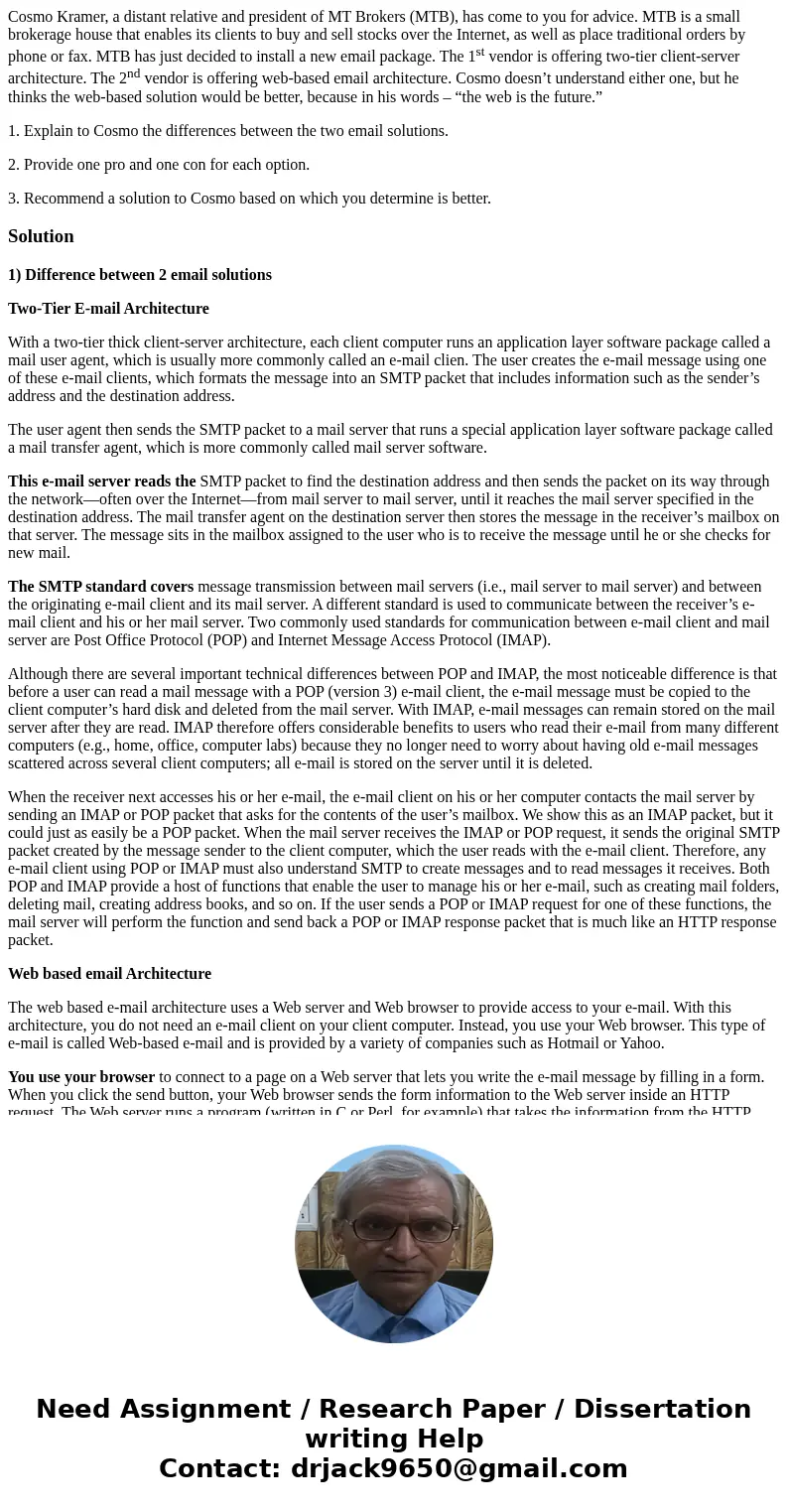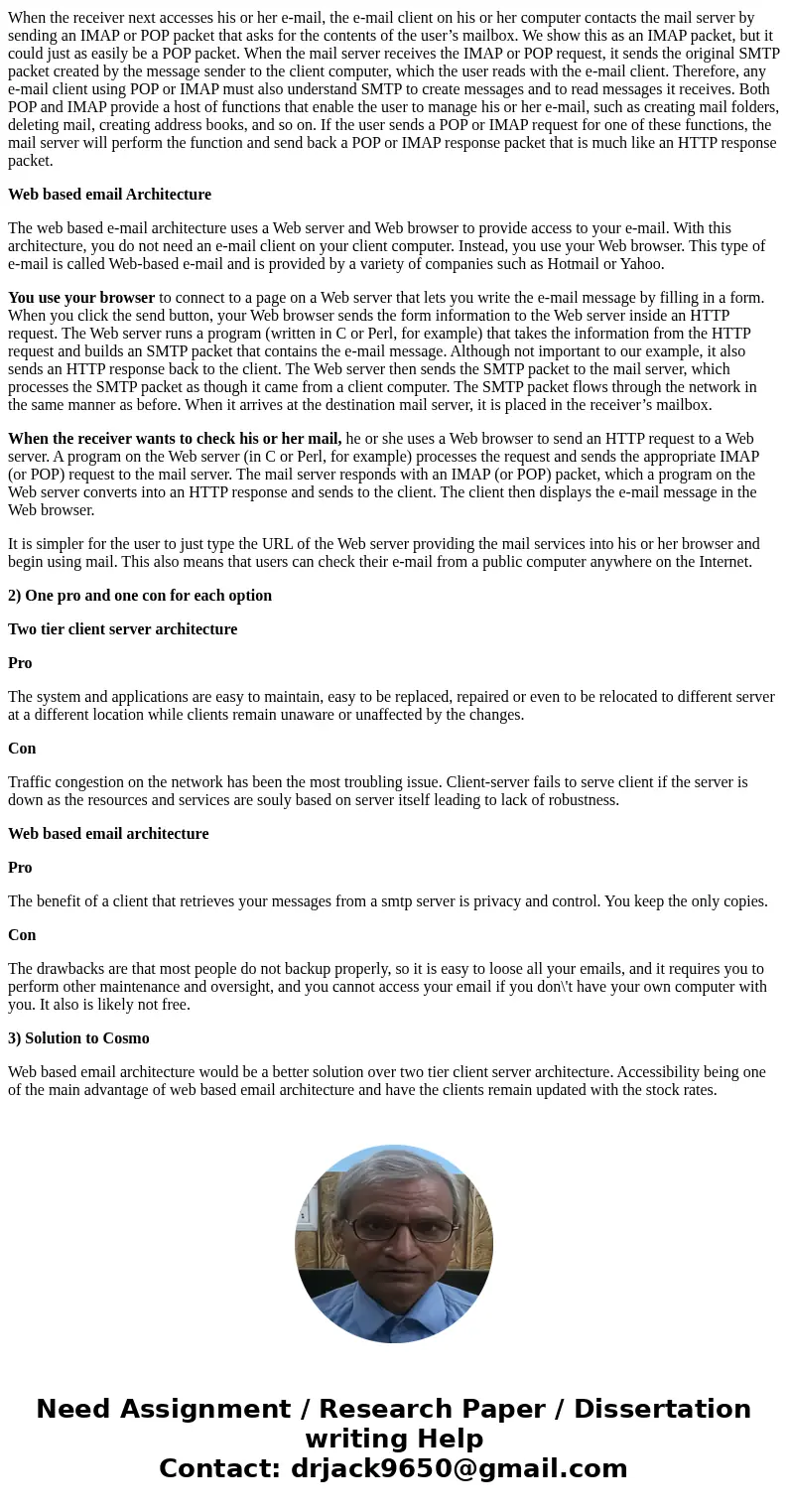Cosmo Kramer a distant relative and president of MT Brokers
Cosmo Kramer, a distant relative and president of MT Brokers (MTB), has come to you for advice. MTB is a small brokerage house that enables its clients to buy and sell stocks over the Internet, as well as place traditional orders by phone or fax. MTB has just decided to install a new email package. The 1st vendor is offering two-tier client-server architecture. The 2nd vendor is offering web-based email architecture. Cosmo doesn’t understand either one, but he thinks the web-based solution would be better, because in his words – “the web is the future.”
1. Explain to Cosmo the differences between the two email solutions.
2. Provide one pro and one con for each option.
3. Recommend a solution to Cosmo based on which you determine is better.
Solution
1) Difference between 2 email solutions
Two-Tier E-mail Architecture
With a two-tier thick client-server architecture, each client computer runs an application layer software package called a mail user agent, which is usually more commonly called an e-mail clien. The user creates the e-mail message using one of these e-mail clients, which formats the message into an SMTP packet that includes information such as the sender’s address and the destination address.
The user agent then sends the SMTP packet to a mail server that runs a special application layer software package called a mail transfer agent, which is more commonly called mail server software.
This e-mail server reads the SMTP packet to find the destination address and then sends the packet on its way through the network—often over the Internet—from mail server to mail server, until it reaches the mail server specified in the destination address. The mail transfer agent on the destination server then stores the message in the receiver’s mailbox on that server. The message sits in the mailbox assigned to the user who is to receive the message until he or she checks for new mail.
The SMTP standard covers message transmission between mail servers (i.e., mail server to mail server) and between the originating e-mail client and its mail server. A different standard is used to communicate between the receiver’s e-mail client and his or her mail server. Two commonly used standards for communication between e-mail client and mail server are Post Office Protocol (POP) and Internet Message Access Protocol (IMAP).
Although there are several important technical differences between POP and IMAP, the most noticeable difference is that before a user can read a mail message with a POP (version 3) e-mail client, the e-mail message must be copied to the client computer’s hard disk and deleted from the mail server. With IMAP, e-mail messages can remain stored on the mail server after they are read. IMAP therefore offers considerable benefits to users who read their e-mail from many different computers (e.g., home, office, computer labs) because they no longer need to worry about having old e-mail messages scattered across several client computers; all e-mail is stored on the server until it is deleted.
When the receiver next accesses his or her e-mail, the e-mail client on his or her computer contacts the mail server by sending an IMAP or POP packet that asks for the contents of the user’s mailbox. We show this as an IMAP packet, but it could just as easily be a POP packet. When the mail server receives the IMAP or POP request, it sends the original SMTP packet created by the message sender to the client computer, which the user reads with the e-mail client. Therefore, any e-mail client using POP or IMAP must also understand SMTP to create messages and to read messages it receives. Both POP and IMAP provide a host of functions that enable the user to manage his or her e-mail, such as creating mail folders, deleting mail, creating address books, and so on. If the user sends a POP or IMAP request for one of these functions, the mail server will perform the function and send back a POP or IMAP response packet that is much like an HTTP response packet.
Web based email Architecture
The web based e-mail architecture uses a Web server and Web browser to provide access to your e-mail. With this architecture, you do not need an e-mail client on your client computer. Instead, you use your Web browser. This type of e-mail is called Web-based e-mail and is provided by a variety of companies such as Hotmail or Yahoo.
You use your browser to connect to a page on a Web server that lets you write the e-mail message by filling in a form. When you click the send button, your Web browser sends the form information to the Web server inside an HTTP request. The Web server runs a program (written in C or Perl, for example) that takes the information from the HTTP request and builds an SMTP packet that contains the e-mail message. Although not important to our example, it also sends an HTTP response back to the client. The Web server then sends the SMTP packet to the mail server, which processes the SMTP packet as though it came from a client computer. The SMTP packet flows through the network in the same manner as before. When it arrives at the destination mail server, it is placed in the receiver’s mailbox.
When the receiver wants to check his or her mail, he or she uses a Web browser to send an HTTP request to a Web server. A program on the Web server (in C or Perl, for example) processes the request and sends the appropriate IMAP (or POP) request to the mail server. The mail server responds with an IMAP (or POP) packet, which a program on the Web server converts into an HTTP response and sends to the client. The client then displays the e-mail message in the Web browser.
It is simpler for the user to just type the URL of the Web server providing the mail services into his or her browser and begin using mail. This also means that users can check their e-mail from a public computer anywhere on the Internet.
2) One pro and one con for each option
Two tier client server architecture
Pro
The system and applications are easy to maintain, easy to be replaced, repaired or even to be relocated to different server at a different location while clients remain unaware or unaffected by the changes.
Con
Traffic congestion on the network has been the most troubling issue. Client-server fails to serve client if the server is down as the resources and services are souly based on server itself leading to lack of robustness.
Web based email architecture
Pro
The benefit of a client that retrieves your messages from a smtp server is privacy and control. You keep the only copies.
Con
The drawbacks are that most people do not backup properly, so it is easy to loose all your emails, and it requires you to perform other maintenance and oversight, and you cannot access your email if you don\'t have your own computer with you. It also is likely not free.
3) Solution to Cosmo
Web based email architecture would be a better solution over two tier client server architecture. Accessibility being one of the main advantage of web based email architecture and have the clients remain updated with the stock rates.


 Homework Sourse
Homework Sourse